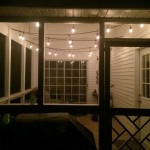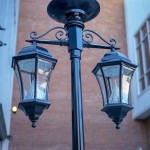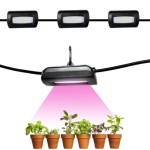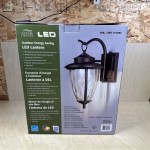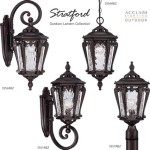Illuminating Your Outdoors: A Comprehensive Guide to LED Outdoor Light Fixtures
Outdoor lighting plays a crucial role in enhancing the safety, security, and aesthetics of residential and commercial properties. LED outdoor light fixtures, in particular, have emerged as the preferred choice for many due to their energy efficiency, longevity, and versatility. This article will delve into the various aspects of LED outdoor lighting, exploring their types, benefits, considerations when selecting fixtures, and installation guidelines.
Understanding the Advantages of LED Technology in Outdoor Lighting
Light Emitting Diodes (LEDs) have revolutionized the lighting industry, offering significant advantages over traditional incandescent, halogen, and fluorescent lighting options. When applied to outdoor lighting, these benefits become even more pronounced. One of the primary advantages is energy efficiency. LEDs consume significantly less power to produce the same amount of light as traditional bulbs. This translates to lower electricity bills and reduced carbon footprint. LED fixtures convert a higher percentage of energy into light, minimizing energy waste through heat generation.
Another significant advantage is the extended lifespan of LEDs. LED outdoor fixtures can last for tens of thousands of hours, often exceeding 50,000 hours or more. This dramatically reduces the frequency of bulb replacements, saving both time and money on maintenance. The durability of LEDs is also a key factor. They are solid-state devices, meaning they have no fragile filaments or glass components that can easily break. This makes them more resistant to shock, vibration, and temperature fluctuations, crucial for withstanding the harsh outdoor environment.
Furthermore, LEDs offer superior light quality. They provide a bright, focused light that accurately renders colors, enhancing visibility and improving security. Unlike some traditional lighting options that may flicker or dim over time, LEDs maintain consistent light output throughout their lifespan. The instant-on capability of LEDs is also advantageous, providing immediate illumination without any warm-up time. This is particularly useful in security lighting applications where immediate response is essential.
Exploring the Diverse Range of LED Outdoor Light Fixture Types
The versatility of LED technology allows for a wide variety of outdoor lighting applications. Several distinct types of LED outdoor light fixtures are available, each designed for specific purposes and aesthetic preferences. Understanding these different types is crucial when selecting the appropriate fixtures for your property.
Flood Lights: These powerful lights are designed to illuminate large areas, making them ideal for security and general outdoor lighting. They typically have a wide beam angle, casting light over a broad space. LED flood lights are often used to illuminate driveways, parking lots, and building facades. They are available in various wattages and light outputs to suit different area sizes and lighting needs.
Spotlights: Unlike flood lights, spotlights have a narrow beam angle, focusing light on a specific object or area. They are commonly used for accent lighting, highlighting architectural features, landscaping elements, or signage. LED spotlights are energy-efficient and offer precise light control, allowing for targeted illumination with minimal light pollution.
Path Lights: These low-level lights are designed to illuminate walkways, pathways, and garden beds. They enhance safety by providing visibility along these routes and add an aesthetic touch to the landscape. LED path lights are available in various styles and designs, from traditional to contemporary, and often feature durable construction to withstand outdoor elements.
Wall Packs: Wall packs are mounted on exterior walls to provide general area lighting. They are commonly used for commercial and industrial buildings, but can also be used in residential settings. LED wall packs are energy-efficient and provide bright, uniform illumination, enhancing security and visibility around buildings.
Bollard Lights: These short, vertical posts are used to illuminate pathways and pedestrian areas. They provide a low-level, directional light that guides people along walkways without causing glare. LED bollard lights are a popular choice for commercial properties, parks, and residential communities.
String Lights: LED string lights offer a decorative and festive lighting solution for outdoor spaces. They can be strung along patios, decks, trees, and fences to create a warm and inviting ambiance. LED string lights are energy-efficient and come in a variety of colors and styles.
Deck Lights: Designed specifically for decks and patios, these lights are often recessed or surface-mounted and provide subtle, ambient lighting. LED deck lights enhance safety and create a relaxing atmosphere for outdoor entertaining.
Underwater Lights: These specialized lights are designed for use in ponds, fountains, and swimming pools. LED underwater lights are waterproof and energy-efficient, adding a dramatic and colorful touch to water features.
Key Considerations When Selecting and Installing LED Outdoor Light Fixtures
Choosing the right LED outdoor light fixtures involves careful consideration of various factors, including light output, color temperature, beam angle, weather resistance, and aesthetic style. Proper installation is also crucial to ensure optimal performance and longevity.
Light Output (Lumens): Light output is measured in lumens, which indicates the total amount of light emitted by a fixture. The appropriate lumen output depends on the specific application. For example, flood lights require higher lumen output than path lights. Consider the size of the area to be illuminated and the desired level of brightness when selecting fixtures with appropriate lumen ratings.
Color Temperature (Kelvin): Color temperature is measured in Kelvin (K) and indicates the warmth or coolness of the light. Lower Kelvin values (e.g., 2700K-3000K) produce a warm, yellowish light, while higher Kelvin values (e.g., 4000K-5000K) produce a cool, bluish-white light. Choose a color temperature that complements the surrounding environment and creates the desired ambiance. Warmer color temperatures are often preferred for residential settings, while cooler color temperatures are commonly used for security and commercial applications.
Beam Angle: The beam angle determines the spread of light. Narrow beam angles are suitable for spotlights, while wide beam angles are better for flood lights. Consider the specific lighting needs and desired effect when selecting fixtures with appropriate beam angles.
Weather Resistance (IP Rating): Outdoor light fixtures must be able to withstand the elements. Look for fixtures with a high Ingress Protection (IP) rating, which indicates the level of protection against dust and water. For general outdoor use, an IP65 rating or higher is recommended. Fixtures exposed to direct rainfall or submersion require even higher IP ratings.
Housing Materials: The housing material of the fixture also impacts its durability and longevity. Common materials include aluminum, stainless steel, and durable plastics. Aluminum and stainless steel are resistant to corrosion and can withstand harsh weather conditions. Ensure that the housing material is appropriate for the intended environment.
Installation Guidelines: Proper installation is crucial for optimal performance and safety. Always follow the manufacturer's instructions when installing LED outdoor light fixtures. Ensure that all electrical connections are properly insulated and protected from moisture. Consider hiring a qualified electrician for complex installations or if you are unfamiliar with electrical work.
Photocells and Timers: Consider using photocells or timers to automate outdoor lighting. Photocells automatically turn lights on at dusk and off at dawn, while timers allow you to set specific on and off times. This can save energy and enhance security.
Dimming Capabilities: Some LED outdoor light fixtures are dimmable, allowing you to adjust the light output to create different moods and conserve energy. Ensure that the fixtures are compatible with the dimmer switch being used.
Warranty: Choose fixtures with a reputable warranty to protect against defects and ensure long-term performance. A longer warranty indicates the manufacturer's confidence in the quality of their product.
By carefully considering these factors and following proper installation guidelines, you can select and install LED outdoor light fixtures that enhance the safety, security, and aesthetics of your property while saving energy and reducing maintenance costs.

Outdoor Led Lighting Exterior Light Fixtures E Conolight

Avenila Led Outdoor Waterproof Modern Wall Light 2w 4w 6w 8w 12w

Can Led Lights Be Used Outdoors Bpm Electric

Outdoor Wall Lights And Sconces Elvi Home

18w Beam Led Outdoor Wall Lamp Up Down Triple Light Fixture Waterproof Door

Factory Directly Square Garden Outdoor Lights Wall Mounted Ip65 Waterproof Light Led Fixture China Lamp Rgb Made In Com

Latitude Run Outdoor Wall Sconce Exterior Ip54 Waterproof Led Light Fixture Kit Classic W Modern Lighting Fixtures Porch

Outdoor Security Lighting Commercial Industrial Led

Waterproof Modern Design Led Double Head Garden Outdoor Wall Lamp Up And Down Lighting Light China Rgb Made In Com

Led Outdoor Lighting Commercial Industrial Revolve
Related Posts
